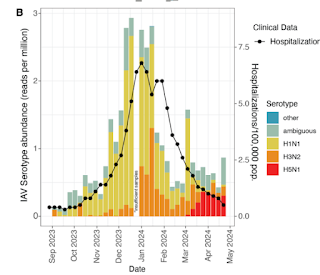#18,061
Four days ago, in Preprint: Virome Sequencing Identifies H5N1 Avian Influenza in Wastewater from Nine (Texas) Cities, we saw the results of a limited study on Texas wastewater systems that detected H5N1 at high levels in samples collected from 9 (unnamed) cities.
While obviously concerning, we don't know the source of this viral contamination, and the lack of symptomatic human cases suggests most of that likely comes from a poultry or bovine source. Some human cases could be involved, but the tests do not parse that out.
To quickly scale up this kind of testing to a national level is undoubtedly an ambitious project - and hopefully we'll get there eventually - but for now the CDC has unveiled a far less specific, but geographically broader wastewater surveillance system for influenza A viruses.
Of 674 reporting stations, just over 1/3rd (n=230) submitted usable samples in the last couple of weeks (see map below). Most reported little or no influenza A activity, but 3 (1%) reported high levels.
First today's report, then I'll have a bit more after the break.
Influenza A Virus Wastewater Data
Updated May 14, 2024
Main Findings from Wastewater Surveillance
- During the two most recent weeks (April 21-May 4), a total of 230 of 674 sites in 34 states reported data meeting criteria for analysis for influenza virus A in both weeks or either week, and 3 (1%) sites from three states were at the high level (>80th percentile compared to levels recorded at that site between October 1, 2023 and March 2, 2024).
Wastewater and the Current Outbreak of Influenza A (H5N1) in birds, cattle, and other animals:
- Current wastewater monitoring methods detect influenza A viruses but do not determine the subtype. This means that avian influenza A(H5N1) viruses can be detected but would not be distinguished from other influenza A virus subtypes.
- Wastewater testing cannot determine the source of the influenza A virus. It could come from a human or from an animal (like a bird) or an animal product (like milk from an infected cow).
- Public health officials at CDC and state and local health departments are monitoring these data. For areas where influenza A virus levels in wastewater are high, CDC works with relevant partners to better understand the factors that could be contributing to these levels.
- Efforts to monitor influenza A virus activity using wastewater data are likely to evolve as the methodologies and interpretation are evaluated and refined.
For the latest information on H5N1, and what you can do to protect yourself, visit H5N1 Bird Flu: Current Situation. For the latest information on influenza activity in people, visit the Weekly U.S. Influenza Surveillance Report.
Number of Wastewater Sites with Data Meeting Criteria for Analysis Reporting Current High Influenza A Levels in Recent Two Weeks: 3 (1% of Total Sites)
Number of Sites with Data Meeting Criteria for Analysis Reportihttps://www.cdc.gov/nwss/pdf/328288_National_Wastewater_Surveillance_System_508.pdfng Influenza A Wastewater Data in Past Two Weeks: 230
Influenza A in Wastewater – Site Level
This interactive map shows current site-level data for influenza A virus in wastewater. Each dot on the map represents a wastewater sampling site. Sites are categorized based on the current level of influenza A compared to the past levels at the same site during the 2023-2024 influenza season. When influenza A virus levels are at the 80th percentile or higher, CDC will work with relevant partners to better understand the factors that could be contributing to these levels.
Wastewater data for influenza A is available for the most recent two weeks: April 21, 2024 – April 27, 2024
April 28, 2024 – May 4, 2024



